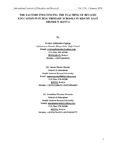| dc.description.abstract | The purpose of this study was to establish factors that influence Human Immunodeficiency Virus/Acquired Immune Deficiency Syndrome (HIV/AIDS) curriculum teaching in public primary schools in Kisumu East district. HIV/AIDS pandemic was declared a national disaster in Kenya in November 1999. Since it was discovered in the early 1980’s it has claimed many lives. New infections occur every day, especially among young people. If humanity is to survive past this century, the seemingly unstoppable pandemic must be checked. Education is one powerful way through which we can stop the spread of the deadly disease. This study adopted the ex-post facto research design. Random sampling technique was used to select the respondents. Data was collected using questionnaires administered to the respondents. The data was descriptively analysed using the Statistical Package for Social Sciences (SPSS) version 17.0 for windows. The findings established that teacher training in HIV/AIDS, HIV/AIDS related resources availability, teacher’s attitudes and lack of examination in HIV/AIDS influence the teaching of HIV/AIDS curriculum in primary schools in the area of study. It was concluded that the rate of HIV/AIDS infection may not reduce significantly because the subject is not being taught as intended, the relevant content need to be incorporated in the teacher training curriculum, in-service training and HIV/AIDS education teaching should made compulsory. The findings of this study are expected to help in the teaching of HIV/AIDS curriculum in Primary school; hence palliate the HIV/AIDS pandemic in the area of study. The study recommended that teachers be trained and oriented in HIV/AIDS education, teaching resource materials be developed and the Ministry of Education endeavour to make the teaching of HIV/AIDS curriculum compulsory. | en_US |

